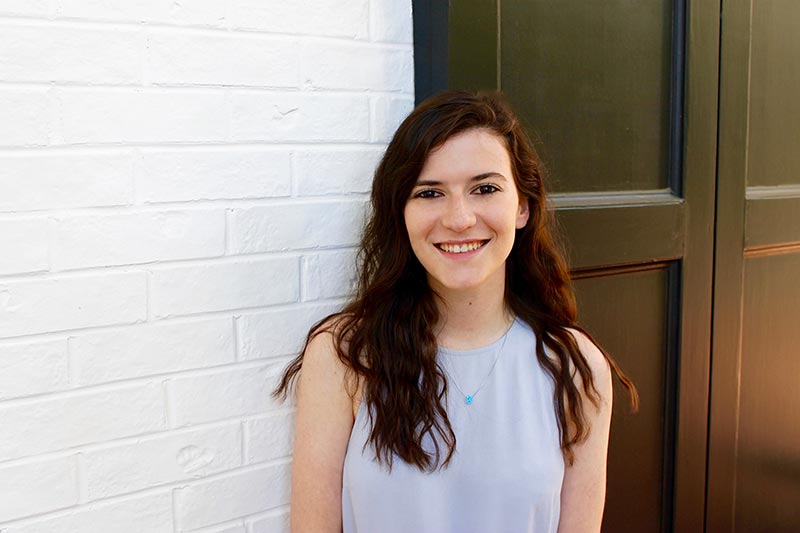A psychology and biology student at The University of Texas at Austin is using the accessibility provided by the web and smartphones to help people who could be in medical need.
Rachel Graubard, a Liberal Arts Honors (LAH) senior from Houston, Texas, has been working on an app that can diagnose and monitor skin cancer since her freshman year.
“I joined the Freshman Research Initiative (FRI) my first semester by starting off in an undergraduate studies class called Research Methods,” Graubard said. “Toward the end of that semester, we had the opportunity to attend information sessions for the various research streams we could join as the next step in the FRI sequence. DIY Diagnostics was definitely my favorite, and I was lucky enough to be placed in my first choice of labs. Smartphones are now so prevalent and they can provide a means to revolutionize healthcare as we know it.”
The DIY Diagnostics lab in the College of Natural Sciences focuses on do-it-yourself projects that emphasize easily available diagnostic tests people can take independently to improve their health. Tim Riedel, research educator for the lab, worked with Rachel on creating her app.
“I’d describe Rachel as creative and brave,” Riedel said. “It is important to include that she did the bulk of this work as a true freshman, including developing the concept. I like to tell people that I’m not a research educator, so much as a facilitator. She made this happen – me, the FRI and DIY just supported her. I have enjoyed working with Rachel and have enjoyed watching her grow into an accomplished ‘maker.’ She fearlessly tackled a project she was passionate about and made incredible progress.”
Graubard first developed an interest in dermatology after learning about a great-great-uncle who was a dermatologist in Vienna. He discovered a rare skin condition that was named after him: Oppenheim-Urbach disease. When Graubard was 13, she received his medical journals from her grandmother.
“Even though I couldn’t understand a word of them, I became really fascinated by the pictures and diagrams and have wanted to be a dermatologist ever since,” Graubard said. “My senior year of high school, I had the opportunity to observe surgeries at Fort Bend Skin Cancer Center, and that really sparked my interest in skin cancers while solidifying my passion for dermatology.”
That led to the idea for her app, which is still a work in progress and doesn’t yet have a name. However, the core of the idea is in place, which allows users to identify warning signs on their skin.
“I know some people can get a little nervous when they notice a strange, dark spot, so the goal is for the app to serve as a first resource before people go to the doctor and help monitor any changes,” Graubard said.
“The app starts by asking the user a series of questions that can be used to distinguish skin cancers from normal lesions based on outwardly visible characteristics,” Graubard said. “For example, skin cancers tend to vary in color throughout, so one of the questions is, ‘Is the color of the lesion consistent?’ Based on the responses to these questions, a probability is calculated of the lesion being skin cancer vs. a benign mole. The user can also upload a picture to compare it to pictures of cancerous lesions.”
In addition to developing the framework for the diagnostic tests, Graubard also wrote the code for the app herself.
“I learned some rudimentary coding techniques from my research educator, Tim Riedel,” she said. “I spent a lot of time sitting at a table in front of the lab making changes to the code and testing those changes every time.”
Her work has paid off. The app has already had an impact on Graubard’s family. Her grandfather recently had a suspicious lesion on his arm, so she showed him how to use it and the result was an 85 percent chance it was cancerous. A visit to the dermatologist and biopsy led to a diagnosis of melanoma and an appointment for removal.
“It’s a huge relief to know that the melanoma was caught early enough to be removed before it spread,” Graubard said. “I’m hoping that the app can help other people be proactive in checking for signs of skin cancer and seeing a doctor if the probability is high.”
So what did her grandfather think of Graubard’s work?
“Well, to be honest, I think he was a bit confused because he doesn’t normally use this kind of technology,” she said. “But I showed him how easy the app was to use, and he seemed to catch on. Like any grandfather, I think he was thrilled to use something his granddaughter created.”
Following graduation, Graubard hopes to attend medical school and continue toward her goal of being a dermatologist.
She also has some words of advice for incoming students.
“When I was applying to college, it was very important to me to get a well-rounded education,” she said. “I didn’t want to only focus on science at the detriment of other important subjects and I especially wanted to hone my writing skills, so I applied to the Liberal Arts Honors program. LAH has given me some incredible opportunities to take classes from amazing professors.
“Make sure to take advantage of all the amazing opportunities this school has to offer,” Graubard said. “I really recommend exploring different areas of study and taking classes outside your major, so you can find something you are truly passionate about.
“Oh, and wear sunscreen! We live in Texas!”
A web-based version of Graubard’s app can be accessed here.
